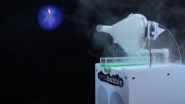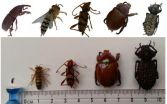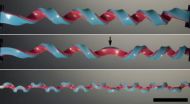(Press-News.org) Multi-sensory technology that creates soap bubbles, which can have images projected onto them or when the bubbles are burst release a scent, will be unveiled at an international conference later this month.
The research paper, to be presented at one of the world's most important conferences on human-computer interfaces - ACM CHI 2014 [26 April-1 May], could be used in areas such as gaming or education and encourage a new way of thinking about multi-sensory technologies.
SensaBubble, led by Professor Sriram Subramanian from the University of Bristol's Department of Computer Science, is a chrono-sensory mid-air display system that generates scented bubbles to deliver information to people using different senses.
The bubble-based technology creates bubbles with a specified size and frequency, fills them with an opaque fog that is optionally scented, controls their route, tracks their location and projects an image onto them.
SensaBubble uses the concept of chrono-sensory experiences where layers of information are presented via different senses for variable length of times, each attracting different types of interest from the user. Firstly, a visual display projected onto the bubble which only lasts until it bursts; secondly, a scent released upon the bursting of the bubble slowly disperses and leaves a longer-lasting noticeable trace.
Sriram Subramanian, Professor of Human-Computer Interaction in the University's Bristol Interaction and Graphics group, said: "The human sense of smell is powerful, but there are few research systems that explore and examine ways to use it. We have taken the first steps to explore how smell can be used to enhance and last longer in a visual object such as a soap bubble.
"There are many areas in which bubble-based technology like SensaBubble could be applied, such as a SensaBubble clock that releases the number of scented bubbles corresponding to the hour or SensaBubble Maths, an educational game for children, which incorporates smell as feedback on their success."
Interactive technologies that are directly targeted at generating public interest and drawing the user's attention have many applications in advertising and certain forms of education, such as museum exhibits.
SensaBubble could be adapted for use in a variety of areas including education, alerts and engaging user experiences.
INFORMATION:
A video of SensaBubble is available on YouTube at: http://www.youtube.com/watch?v=JGUmf4HqTxM
Paper: SensaBubble: a chrono-sensory mid-air display of sight and smell, Sue Ann Seah, Diego Martinez Plasencia, Peter Bennett, Abhijit Karnik, Vlad Otrocol, Jarrod Knibbe, Andy Cockburn, and Sriram Subramanian, Proceedings of ACM CHI 2014 Conference on Human Factors in Computing Systems. Toronto, Canada. 2014., 26 April-1 May 2014.
It's a bubble, but not as we know it
2014-04-24
ELSE PRESS RELEASES FROM THIS DATE:
The Lancet Global Health: Recurrent violence linked to substantially higher rates of mental disorders in post-conflict communities
2014-04-24
In the aftermath of war, communities who continue to experience repeated violence could have a major escalation in rates of post-traumatic stress disorder (PTSD) and severe distress, suggests new research published in The Lancet Global Health journal.
In 2004, Dr Derrick Silove from the University of New South Wales in Sydney, Australia, and colleagues conducted a survey to estimate the prevalence of common mental disorders among 1022 adults (600 from a rural village and 422 from an urban district) in Timor Leste four years after the end of a long-running and violent ...
The Lancet Diabetes & Endocrinology: Vitamin D supplements have little effect on risk of falls in older people
2014-04-24
A new meta-analysis, published in The Lancet Diabetes & Endocrinology journal, concludes that there is no evidence to suggest that vitamin D supplements prevent falls, and that ongoing trials to test this theory are unlikely to change this result.
The study, by Dr Mark Bolland of the University of Auckland, New Zealand, and colleagues, analysed findings from 20 randomised controlled trials which tested the potential of vitamin D supplements to reduce falls, in a total of 29535 people. The findings show that supplements do not reduce falls by 15% or more, meaning that the ...
Citizen scientists match research tool when counting sharks
2014-04-24
Shark data collected by citizen scientists may be as reliable as data collected using automated tools, according to results published April 23, 2014, in the open access journal PLOS ONE by Gabriel Vianna from The University of Western Australia and colleagues.
Shark populations are declining globally, and scientists lack data to estimate the conservation status of populations for many shark species. Citizen science may be a useful and cost-effective means to increase knowledge of shark populations on coral reefs, but scientists do not yet know enough about how data collected ...
'Off-the-shelf' equipment used to digitize insects in 3-D
2014-04-24
Scientists have developed a cost-effective, off-the-shelf system to obtain natural-color 3D models of insects, according to results published April 23, 2014, in the open access journal PLOS ONE by Chuong Nguyen from CSIRO in Australia, and colleagues.
Scientists studying insects rely on collected specimens that are often shared between scientists through written descriptions, diagrams, and images. These 2D tools are important in understanding and sharing specimens, but they often lack the precise detail of the actual 3D specimen. The authors of this study, interested in ...
Stem cells in circulating blood affect cardiovascular health, study finds
2014-04-24
COLUMBUS, Ohio – New research suggests that attempts to isolate an elusive adult stem cell from blood to understand and potentially improve cardiovascular health – a task considered possible but very difficult – might not be necessary.
Instead, scientists have found that multiple types of cells with primitive characteristics circulating in the blood appear to provide the same benefits expected from a stem cell, including the endothelial progenitor cell that is the subject of hot pursuit.
"There are people who still dream that the prototypical progenitors for several ...
Scientists discover a new shape using rubber bands
2014-04-24
Cambridge, Mass. – April 23, 2014 – While setting out to fabricate new springs to support a cephalopod-inspired imaging project, a group of Harvard researchers stumbled upon a surprising discovery: the hemihelix, a shape rarely seen in nature.
This made the researchers wonder: Were the three-dimensional structures they observed randomly occurring, or are there specific factors that control their formation? The scientists answered that question by performing experiments in which they stretched, joined, and then released rubber strips. Complemented by numerical simulations ...
Microbes provide insights into evolution of human language
2014-04-24
Big brains do not explain why only humans use sophisticated language, according to researchers who have discovered that even a species of pond life communicates by similar methods.
Dr Thom Scott-Phillips of Durham University led research into Pseudomonas aeruginosa, a type of bacteria common in water and soil, which showed that they communicated in a way that was previously thought to be unique to humans and perhaps some other primates.
The bacteria used combinatorial communication, in which two signals are used together to achieve an effect that is different to the ...
People with mild cognitive impairment may die at higher rate than people without condition
2014-04-23
ROCHESTER, Minn. — Mayo Clinic research studying the relationship between death and the two types of mild cognitive impairment (MCI) suggests that people who have these conditions die at a higher rate than people without MCI. The research was released today and will be presented at the American Academy of Neurology's 66th Annual Meeting in Philadelphia, April 26 to May 3, 2014.
For the study, 862 people with thinking problems and 1,292 with no thinking problems between the ages of 70 and 89 were followed for nearly six years. Over the course of the study, 331 of the ...
People with more education may recover better from traumatic brain injury
2014-04-23
MINNEAPOLIS – People with more years of education may be better able to recover from a traumatic brain injury, according to a study published in the April 23, 2014, online issue of Neurology®, the medical journal of the American Academy of Neurology.
The study examined people with moderate to severe traumatic brain injuries, most of which were from motor vehicle accidents or falls. All were taken to the emergency department and spent time in the hospital after the injury and also for inpatient rehabilitation.
"After these types of injuries, some people are disabled ...
Study examines risk of early death for people with mild cognitive impairment
2014-04-23
PHILADELPHIA – One of the first studies to look at a relationship between death and the two types of mild cognitive impairment (MCI), or problems with memory and thinking abilities, suggests that people who have thinking problems but their memory is still intact might have a higher death rate in a period of six years compared to those who have no thinking or memory problems. The research was released today and will be presented at the American Academy of Neurology's 66th Annual Meeting in Philadelphia, April 26 to May 3, 2014. The same was suggested in the study for those ...




